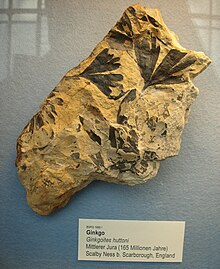bio.wikisort.org - Plant
Ginkgoites is a genus that refers to extinct plants belonging to Ginkgoaceae. Fossils of these plants have been found around the globe during the Triassic, Jurassic, Cretaceous, with fossils also known from the Paleogene. The name was created as a form genus in 1919 by Albert Seward who stated: "I ... propose to employ the name Ginkgoites for leaves that it is believed belong either to plants generically identical with Ginkgo or to very closely allied types".[2]
| Ginkgoites Temporal range: Late Triassic-Late Cretaceous ~ | |
|---|---|
 | |
| fossil leaves identified as Gingkoites | |
| Scientific classification | |
| Kingdom: | Plantae |
| Clade: | Tracheophytes |
| Clade: | Gymnosperms |
| Division: | Ginkgophyta |
| Class: | Ginkgoopsida |
| Order: | Ginkgoales |
| Family: | Ginkgoaceae |
| Genus: | †Ginkgoites Seward, 1919 emend. Watson et al., 1999 |
| Type species | |
| Ginkgoites sibirica[1] (Heer) Seward, 1919 | |
| Other species | |
| |
References
- Villar De Seoane, L.; Cúneo, N. R.; Escapa, I.; Wilf, P.; Gandolfo, M. A. (2015). "Ginkgoites patagonica (Berry) comb. nov. from the Eocene of Patagonia, Last Ginkgoalean Record in South America". International Journal of Plant Sciences. 176 (4): 346–263. doi:10.1086/680221.
- Albert Charles Seward (1919), Fossil plants: for students of botany and geology, vol. 4, Cambridge University Press, p. 10, doi:10.5962/bhl.title.54901
Текст в блоке "Читать" взят с сайта "Википедия" и доступен по лицензии Creative Commons Attribution-ShareAlike; в отдельных случаях могут действовать дополнительные условия.
Другой контент может иметь иную лицензию. Перед использованием материалов сайта WikiSort.org внимательно изучите правила лицензирования конкретных элементов наполнения сайта.
Другой контент может иметь иную лицензию. Перед использованием материалов сайта WikiSort.org внимательно изучите правила лицензирования конкретных элементов наполнения сайта.
2019-2025
WikiSort.org - проект по пересортировке и дополнению контента Википедии
WikiSort.org - проект по пересортировке и дополнению контента Википедии